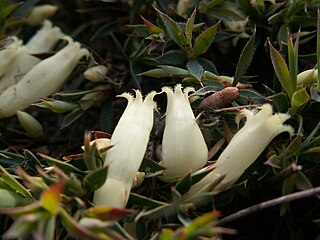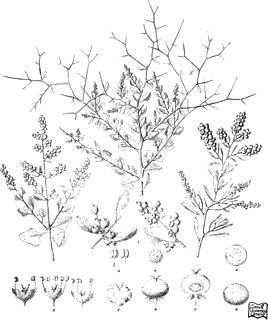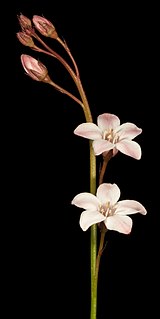Prodromus Florae Novae Hollandiae et Insulae Van Diemen is a flora of Australia written by botanist Robert Brown and published in 1810. Often referred to as Prodromus Flora Novae Hollandiae, or by its standard botanical abbreviation Prodr. Fl. Nov. Holland., it was the first attempt at a survey of the Australian flora. It described over 2040 species, over half of which were published for the first time.
Plantago debilis is a species of herb native to Australia. Common names include shade plantain and weak plantain.
Xerochloa is a genus of Australian and Southeast Asian plants in the grass family.

Anisopogon is a genus of Australian plants in the grass family. The only known species is Anisopogon avenaceus, native to Victoria and New South Wales. It is known commonly as oat speargrass. It is a perennial grass growing up to 1.5 metres tall, bearing spikelets up to 6 centimetres long.

Dianella revoluta, commonly known as blueberry lily, blue flax-lily, or black-anther flax-lily, a species of flowering plant in the family Asphodelaceae and is endemic to, and widespread in Australia. It is a tufted, perennial herb with grass-like leaves and up to nine blue or violet flowers with six tepals, and stamens with bright yellow filaments and pale brown to almost black anthers.

Hakea lorea, commonly known as bootlace oak or cork tree, is a species of shrub or small tree in the family Proteaceae found in central and northern Australia. It has needle-shape leaves, yellow, white or green flowers and hard corky bark.

Ajuga australis, commonly known as Austral bugle, is a herbaceous flowering plant native to Eastern Australia. First described by Robert Brown, it is occasionally seen in horticulture.

Isopogon trilobus, commonly known as barrel coneflower, is a species of flowering plant in the family Proteaceae and is endemic to south coastal regions of Western Australia. It is a shrub with wedge-shaped leaves with lobed or toothed leaves, and oval, spherical or barrel-shaped heads of cream-coloured to yellow flowers.

Johnsonia is a genus five species of herbs in the family Asphodelaceae, all of which are endemic to the south-west of Western Australia. They are grass-like plants with minute flowers surrounded by bracts which are often tinged with white, pink or cream.

Astroloma pallidum, commonly known as kick bush, is usually a small, compact shrub in the family Ericaceae. The species is endemic to south-western Western Australia.

Diuris longifolia is a species of orchid which is endemic to the south-west of Western Australia. It has a variety of common names including purple pansy orchid, donkey orchid, common donkey orchid and wallflower orchid. It was one of the first three terrestrial orchids to be named from Western Australia, along with Caladenia menziesii and Caladenia flava.

Schizaea rupestris is a small Australian fern. Most populations are in found in the ranges near Sydney. However, it also occurs near Woolgoolga and Western Australia.

Myoporum oppositifolium, commonly known as twin-leaf myoporum, is a plant in the figwort family, Scrophulariaceae. It is easily distinguished from others in the genus by the combination of glabrous leaves and branches, its opposite leaf arrangement and its serrated leaves. Its distribution is restricted to the extreme south-west of Western Australia.

Triodia pungens, commonly known as soft spinifex, is a species of grass native to northwestern Australia.

Patersonia occidentalis, commonly known as purple flag or long purple flag, is a perennial herbaceous plant that is endemic to Western Australia. The Noongar name for the plant is komma.
Thelymitra fuscolutea, commonly called the chestnut sun orchid, is a species of orchid in the family Orchidaceae and is endemic to the south-west of Western Australia. It has a single erect, flat, leathery leaf and up to fifteen or more yellowish green flowers with reddish brown streaks and blotches. The column has broad, deeply fringed cream or whitish wings.

Chenopodium spinescens is a species of plant in the family Amaranthaceae, endemic to Australia. It is found in all states and territories of Australia with the exception of Tasmania.
Anarthria scabra is a herbaceous plant found in Southwest Australia. The form is sedge- or rush-like, with groups of flowers that present a brown and yellow inflorescence; this appears around August to December, the height of this robust plant is 0.35 to 1.5 metres. The perennial leaves emerge from a rhizomatous base, usually long and sedge-like these are typically hairless with an entire margin. They occur at sand dunes on white or grey sand, or peaty sands, often in areas that are wet in winter. The distribution range is coastal and sub coastal habitat from the Swan Coastal Plain, south of Perth, to the increasingly arid Esperance Plains.

Scaevola nitida is an erect shrub in the family Goodeniaceae, native to Western Australia. It grows to a height of 0.3 to 3 m, and its blue-purple flowers may be seen from August to December.

Samolus junceus in the family Primulaceae is a species of water pimpernel native to Western Australia.
















